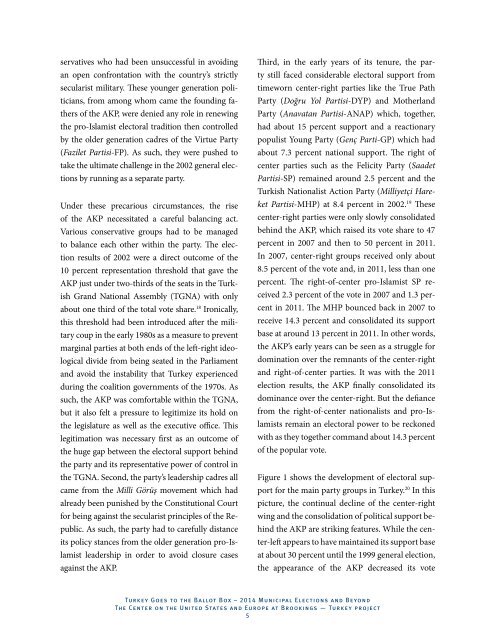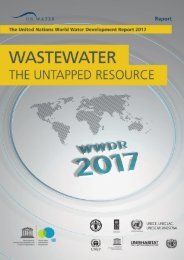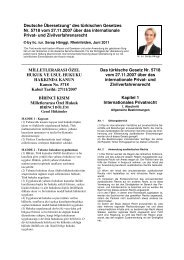13 turkey ballot box municipal elections carkoglu
13 turkey ballot box municipal elections carkoglu
13 turkey ballot box municipal elections carkoglu
Create successful ePaper yourself
Turn your PDF publications into a flip-book with our unique Google optimized e-Paper software.
servatives who had been unsuccessful in avoiding<br />
an open confrontation with the country’s strictly<br />
secularist military. These younger generation politicians,<br />
from among whom came the founding fathers<br />
of the AKP, were denied any role in renewing<br />
the pro-Islamist electoral tradition then controlled<br />
by the older generation cadres of the Virtue Party<br />
(Fazilet Partisi-FP). As such, they were pushed to<br />
take the ultimate challenge in the 2002 general <strong>elections</strong><br />
by running as a separate party.<br />
Under these precarious circumstances, the rise<br />
of the AKP necessitated a careful balancing act.<br />
Various conservative groups had to be managed<br />
to balance each other within the party. The election<br />
results of 2002 were a direct outcome of the<br />
10 percent representation threshold that gave the<br />
AKP just under two-thirds of the seats in the Turkish<br />
Grand National Assembly (TGNA) with only<br />
about one third of the total vote share. 18 Ironically,<br />
this threshold had been introduced after the military<br />
coup in the early 1980s as a measure to prevent<br />
marginal parties at both ends of the left-right ideological<br />
divide from being seated in the Parliament<br />
and avoid the instability that Turkey experienced<br />
during the coalition governments of the 1970s. As<br />
such, the AKP was comfortable within the TGNA,<br />
but it also felt a pressure to legitimize its hold on<br />
the legislature as well as the executive office. This<br />
legitimation was necessary first as an outcome of<br />
the huge gap between the electoral support behind<br />
the party and its representative power of control in<br />
the TGNA. Second, the party’s leadership cadres all<br />
came from the Milli Görüş movement which had<br />
already been punished by the Constitutional Court<br />
for being against the secularist principles of the Republic.<br />
As such, the party had to carefully distance<br />
its policy stances from the older generation pro-Islamist<br />
leadership in order to avoid closure cases<br />
against the AKP.<br />
Third, in the early years of its tenure, the party<br />
still faced considerable electoral support from<br />
timeworn center-right parties like the True Path<br />
Party (Doğru Yol Partisi-DYP) and Motherland<br />
Party (Anavatan Partisi-ANAP) which, together,<br />
had about 15 percent support and a reactionary<br />
populist Young Party (Genç Parti-GP) which had<br />
about 7.3 percent national support. The right of<br />
center parties such as the Felicity Party (Saadet<br />
Partisi-SP) remained around 2.5 percent and the<br />
Turkish Nationalist Action Party (Milliyetçi Hareket<br />
Partisi-MHP) at 8.4 percent in 2002. 19 These<br />
center-right parties were only slowly consolidated<br />
behind the AKP, which raised its vote share to 47<br />
percent in 2007 and then to 50 percent in 2011.<br />
In 2007, center-right groups received only about<br />
8.5 percent of the vote and, in 2011, less than one<br />
percent. The right-of-center pro-Islamist SP received<br />
2.3 percent of the vote in 2007 and 1.3 percent<br />
in 2011. The MHP bounced back in 2007 to<br />
receive 14.3 percent and consolidated its support<br />
base at around <strong>13</strong> percent in 2011. In other words,<br />
the AKP’s early years can be seen as a struggle for<br />
domination over the remnants of the center-right<br />
and right-of-center parties. It was with the 2011<br />
election results, the AKP finally consolidated its<br />
dominance over the center-right. But the defiance<br />
from the right-of-center nationalists and pro-Islamists<br />
remain an electoral power to be reckoned<br />
with as they together command about 14.3 percent<br />
of the popular vote.<br />
Figure 1 shows the development of electoral support<br />
for the main party groups in Turkey. 20 In this<br />
picture, the continual decline of the center-right<br />
wing and the consolidation of political support behind<br />
the AKP are striking features. While the center-left<br />
appears to have maintained its support base<br />
at about 30 percent until the 1999 general election,<br />
the appearance of the AKP decreased its vote<br />
Turkey Goes to the Ballot Box – 2014 Municipal Elections and Beyond<br />
The Center on the United States and Europe at Brookings — Turkey project<br />
5




